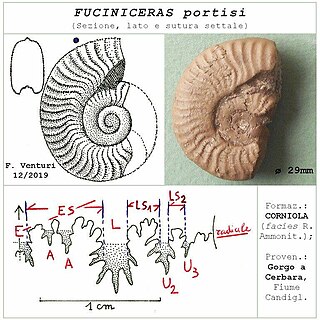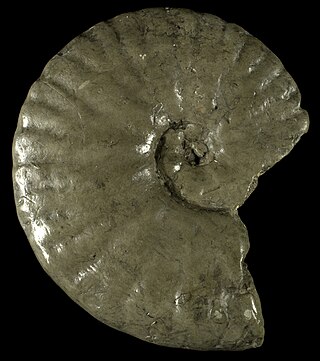Alligaticeras is an extinct genus of cephalopod belonging to the ammonite subclass.

Aulacostephanus is an extinct ammonoid cephalopod genus from the Upper Jurassic Tithonian belonging to the perisphinctoidean family Aulacostephanidae.

Apoderoceras is an extinct genus of cephalopod belonging to the ammonite subclass.

Fuciniceras is an extinct cephalopod genus included in the ammonoid family Hildoceratidae,, that lived during the Pliensbachian stage of the Early Jurassic. The shell of Fuciniceras is generally small, evlute, and strongly ribbed.
Bradfordia is a moderately involute to involute genus included in the ammonoid cephalopod family Oppeliidae, coiled so that the outer whorl encloses most, or much, of the previous, but with a small umbilicus exposing inner whorls. The shell is compressed, whorl height much greater than width, extending well out from the contact with the adjacent inner whorl. Outer flanks are finely ribbed and the rounded venter is smooth.
Diplesioceras is an extinct genus from a well-known class of fossil cephalopods, the ammonites. It lived during the Bajocian.
Eudmetoceras is an extinct genus from a well-known class of fossil cephalopods, the ammonites. It lived during the Jurassic Period, which lasted from 171.6 to 168.4 million years ago.
Epistrenoceras is an extinct genus from a well-known class of fossil cephalopods, the ammonites. It lived during the Bajocian to the Bathonian.
Eocephalites is an extinct genus from a well-known class of fossil cephalopods, the ammonites. It lived during the Bajocian.
Emileia is an extinct genus from a well-known class of fossil cephalopods, the ammonites, that lived during the early part of the Bajocian.

Durotrigensia is a genus of ammonites (Ammonitida) in the perisphinctoid family Parkinsoniidae.

Phylloceras is an extinct genus of ammonoid cephalopods belonging to the family Phylloceratidae. These nektonic carnivores lived from Early Jurassic to Late Cretaceous.
Crucilobiceras is an ammonoid cephalopod genus from the Lower Jurassic belonging to the eoderoceratoidean family Eoderoceratidae. Cruciliboceras has an evolute shell, such that all whorls are well exposed, with persistent radial ribbing and with spines or tubercles on the outer, ventral, rim, and in some, tubercles in the inner, umbilical, rim. The genus Crucilobiceras is commonly found along the Jurassic Coast of England.

Pachydesmoceras is a genus of ammonites belonging to the family Desmoceratidae.

Belemnites is a genus of an extinct group of cephalopods belonging to the order Belemnitida. These cephalopods existed in the Early Jurassic period from the Hettangian age to the Toarcian age (175.6–183.0). They were fast-moving nektonic carnivores.
Neophylloceras is an extinct genus of cephalopod belonging to the Ammonite subclass.

Metoioceras is an extinct genus of cephalopod belonging to the Ammonite subclass which lived during the Cenomanian.

Eucalycoceras is an extinct genus of cephalopods belonging to the Ammonite subclass.

Sowerbyceras is a genus of ammonoid cephalopods belonging to the family Phylloceratidae. These nektonic carnivores lived during the Jurassic period, from Oxfordian to Kimmeridgian age.

Harpoceras is an extinct genus of ammonite belonging to the family Hildoceratidae. These cephalopods existed in the Jurassic period, during the Toarcian age from the Falciferum zone to the Commune subzone of the Bifrons zone. They were fast-moving nektonic carnivores.












